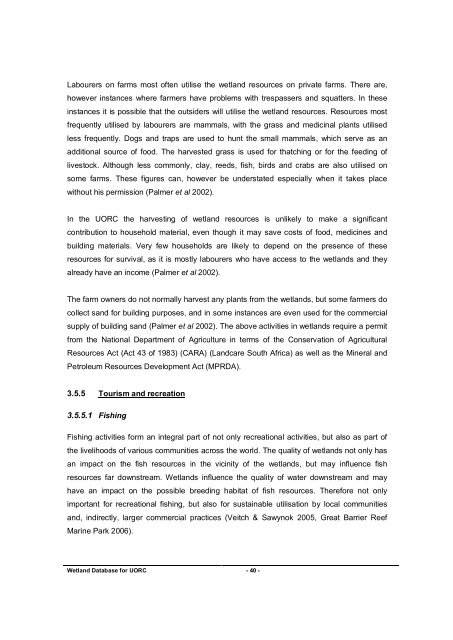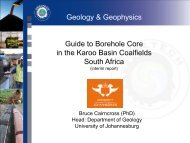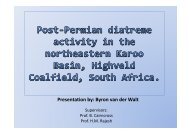coaltech upper olifants river catchment wetland inventory ...
coaltech upper olifants river catchment wetland inventory ...
coaltech upper olifants river catchment wetland inventory ...
Create successful ePaper yourself
Turn your PDF publications into a flip-book with our unique Google optimized e-Paper software.
Labourers on farms most often utilise the <strong>wetland</strong> resources on private farms. There are,<br />
however instances where farmers have problems with trespassers and squatters. In these<br />
instances it is possible that the outsiders will utilise the <strong>wetland</strong> resources. Resources most<br />
frequently utilised by labourers are mammals, with the grass and medicinal plants utilised<br />
less frequently. Dogs and traps are used to hunt the small mammals, which serve as an<br />
additional source of food. The harvested grass is used for thatching or for the feeding of<br />
livestock. Although less commonly, clay, reeds, fish, birds and crabs are also utilised on<br />
some farms. These figures can, however be understated especially when it takes place<br />
without his permission (Palmer et al 2002).<br />
In the UORC the harvesting of <strong>wetland</strong> resources is unlikely to make a significant<br />
contribution to household material, even though it may save costs of food, medicines and<br />
building materials. Very few households are likely to depend on the presence of these<br />
resources for survival, as it is mostly labourers who have access to the <strong>wetland</strong>s and they<br />
already have an income (Palmer et al 2002).<br />
The farm owners do not normally harvest any plants from the <strong>wetland</strong>s, but some farmers do<br />
collect sand for building purposes, and in some instances are even used for the commercial<br />
supply of building sand (Palmer et al 2002). The above activities in <strong>wetland</strong>s require a permit<br />
from the National Department of Agriculture in terms of the Conservation of Agricultural<br />
Resources Act (Act 43 of 1983) (CARA) (Landcare South Africa) as well as the Mineral and<br />
Petroleum Resources Development Act (MPRDA).<br />
3.5.5 Tourism and recreation<br />
3.5.5.1 Fishing<br />
Fishing activities form an integral part of not only recreational activities, but also as part of<br />
the livelihoods of various communities across the world. The quality of <strong>wetland</strong>s not only has<br />
an impact on the fish resources in the vicinity of the <strong>wetland</strong>s, but may influence fish<br />
resources far downstream. Wetlands influence the quality of water downstream and may<br />
have an impact on the possible breeding habitat of fish resources. Therefore not only<br />
important for recreational fishing, but also for sustainable utilisation by local communities<br />
and, indirectly, larger commercial practices (Veitch & Sawynok 2005, Great Barrier Reef<br />
Marine Park 2006).<br />
Wetland Database for UORC - 40 -




